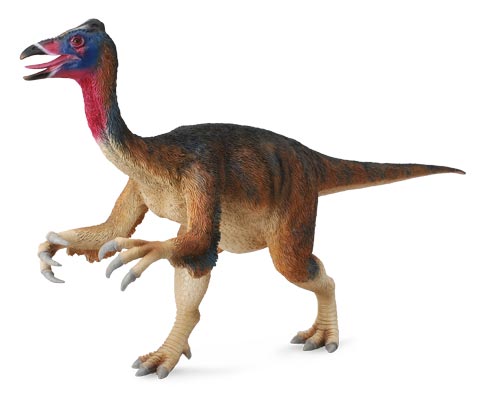American Researchers Study Changes in Body Size for Feathered Dinosaurs who were Facultative Herbivores
A team of researchers from the United States have challenged a theory regarding how the likes of the Oviraptors, ornithomimids and the therizinosaurs evolved over time. Fossils of these types of dinosaur have been found in Upper Cretaceous aged rocks across the Northern Hemisphere. Palaeontologists believe that these types of dinosaur, classified as theropods, adapted to a herbivorous diet, or at least became omnivorous, eating less meat. Oviraptors, ornithomimids and the therizinosaurs were descended from dinosaurs that were carnivores. However, over time they adapted to eating plants and some of these dinosaurs, those found in Maastrichtian or Campanian aged faunal strata (the very end of the Cretaceous), evolved into giants.
Giant Feathered Dinosaurs – Researching into “Big Birds”
Picture credit: North Carolina State University, with additional annotations by Everything Dinosaur
Feathered Dinosaurs
One of the theories postulated about why some of these dinosaurs grew so big, states that large size was an advantage as this enabled herbivores to evolve larger guts and digestive tracts that would be needed to help them process tough, fibrous plant material efficiently so that nutrients could be extracted. Some genera did grow big! For example, the dinosaur known as Gigantoraptor (G. erlianensis), fossils of which were discovered in Inner Mongolia in 2005, was tall enough to look Tyrannosaurus rex in the eye. This fossil specimen indicates an animal over five metres tall and eight metres long, weighing perhaps as much as one and a half metric tonnes.
To view replicas of feathered dinosaurs: CollectA Deluxe Models – Feathered Dinosaur Figures.
The Chinese scientists who made the discovery, have estimated that this individual was not fully grown so adult Gigantoraptors were probably much bigger. Gigantoraptor has been classified as a member of the Oviraptoridae. Most of the other members of the Oviraptor family were much smaller.
Examples of Gigantism
Similar examples of gigantism can be found in the ornithomimids and the therizinosaurids. Therizinosaurus cheloniformis, also from Mongolia; may have been up to twelve metres in length, many times bigger than other therizinosaurs, or as they are sometimes called segnosaurs. Amongst the Late Cretaceous members of the Ornithomimosauria, there were also giants. A pair of 2.6 metre long arms discovered in the Nemegt Formation (Gobi desert of Mongolia) in 1965 have been ascribed to an enormous ornithomimid which was perhaps up to twelve metres in length. This dinosaur was formally named and described in 1970, the world was introduced to Deinocheirus mirificus (terrible hand). Despite its terrifying hands, this dinosaur is not thought to have been a carnivore.
Deinocheirus – “Terrible Hands”
Picture credit: Everything Dinosaur
Closely Related to Modern Birds
Most species belonging to these three types of dinosaur family possessed a horny, toothless beak and relatively small heads in proportion to the size of their bodies. A number of fossils found also indicate that these dinosaurs may have been covered in simple, proto-feathers, designed not for flight but to help insulate these active animals and keep them warm. Palaeontologists think that creatures such as the Oviraptoridae were closely related to today’s modern birds.
The research team from North Carolina, aided by colleagues from the Field Museum in Chicago, mapped out the fossil evidence from these three different types of dinosaur and attempted to model whether as the animals evolved they tended to generally increase in body size. Statistical analysis was employed to test whether the theory that later forms of these prehistoric animals were indeed larger than their ancestors.
The scientists discovered, that although there were giant forms, there was not a clear linear trend towards gigantism with these types of dinosaur. The evolution for the trait that makes an animal bigger than its ancestors seems to have been a passive process, there may have been large forms, but at the same time many types of ornithomimids, members of the Oviraptoridae and therizinosaurs remained small.
Published in an Academic Journal
The academic paper detailing the results of this analysis have been published in the scientific journal, the Proceedings of the Royal Society – Biology. The evidence suggests that just because a dinosaur adapts to a more herbivorous diet does not necessarily mean that they have to evolve into bigger forms to accommodate a larger gut. The work of these scientists does not rule out diet as affecting the size of animals, but suggests that other factors such as stable environments, the lack of competition and the amount of resources within a habitat play a significant part.
Where resources were plentiful, such as the area that was to form the strata of the Nemegt Formation of Mongolia, some types of therizinosaur for instance could grow into a giant form (T. cheloniformis), however, in other parts of the world, perhaps where there was more competition from other herbivorous dinosaurs gigantism did not occur.
The conclusions made by the researchers do challenge some of the accepted thinking about these dinosaurs. There is a problem with this study, one that is acknowledged by the research team. The fossil record for these prehistoric animals is far from complete and in their study, some uneven sampling of the fossil material may have taken place. If it is assumed that smaller species tend to be more abundant in an environment than large species and if it is assumed that more specimens of smaller species will be preserved as fossils as a result, then the amount of small dinosaurs known from the fossil record may be an over representation of their actual numbers, whilst larger species the likes of Deinocheirus, Therizinosaurus and Gigantoraptor may be understated.






I’m sorry but the Gigantoraptor was discovered in Erlian basin of Inner Mongolia(China),not Mongolia.
Noted and corrected – our thanks for pointing out the confusion we had between our Mongolias.